09 STM32F429 RCC时钟
对时钟树流程的简单理解
时钟树图
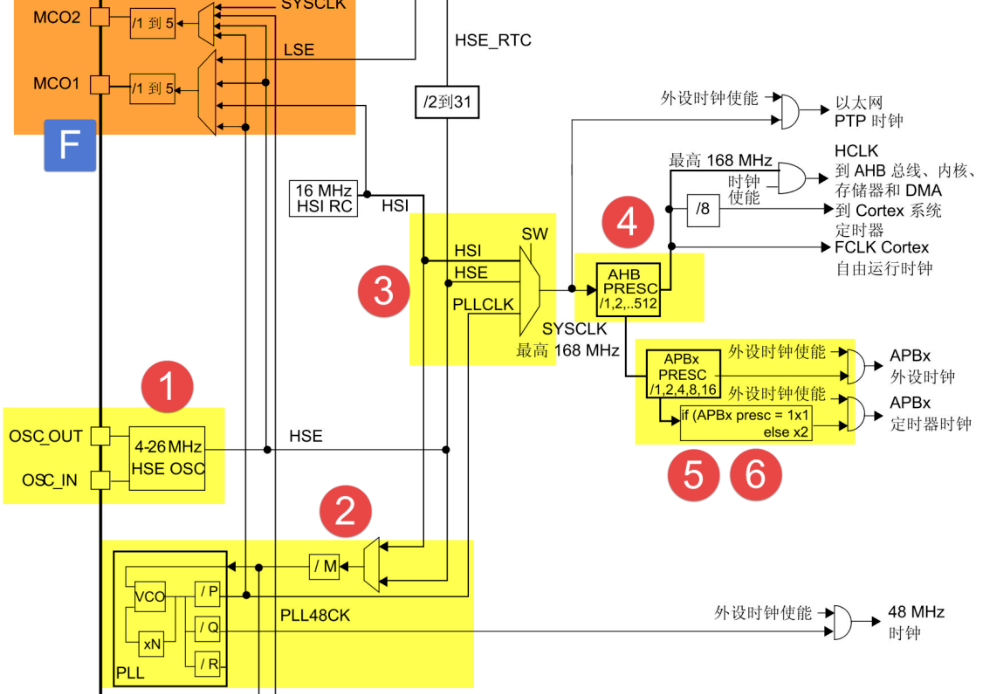
-
HSE是高速外部时钟信号, HSI是高速内部时钟信号,通常使用HSE,因为HSI在内部受温度等影响不稳定
-
HSE的频率一般为8MHZ,使用RCC_CR的16位进行使能,17位读取时钟是否已经就绪
RCC基地址

RCC_CR寄存器

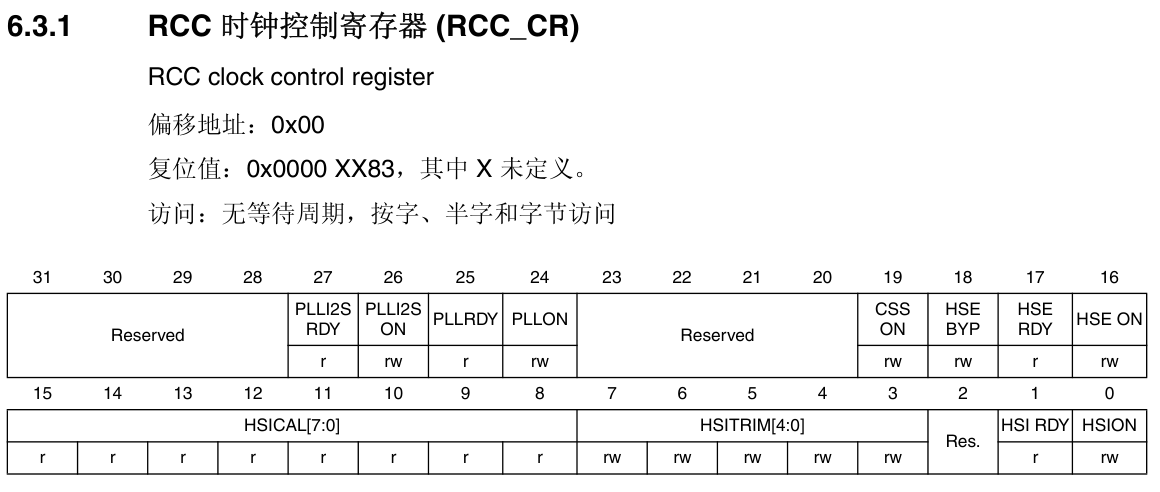
判断HSE是否启动成功
__IO uint32_t StartUpCounter = 0, HSEStatus = 0;
/* Enable HSE */
RCC->CR |= ((uint32_t)RCC_CR_HSEON);
/* Wait till HSE is ready and if Time out is reached exit */
do
{
HSEStatus = RCC->CR & RCC_CR_HSERDY;
StartUpCounter++;
} while((HSEStatus == 0) && (StartUpCounter != HSE_STARTUP_TIMEOUT));
if ((RCC->CR & RCC_CR_HSERDY) != RESET)
{
HSEStatus = (uint32_t)0x01;
}
else
{
HSEStatus = (uint32_t)0x00;
}
RCC_CFGR寄存器
[外链图片转存失败,源站可能有防盗链机制,建议将图片保存下来直接上传(img-fCU9wNne-1664218657494)(https://picture-1309470925.cos.ap-chengdu.myqcloud.com/pic/image-20220926232933972.png)]
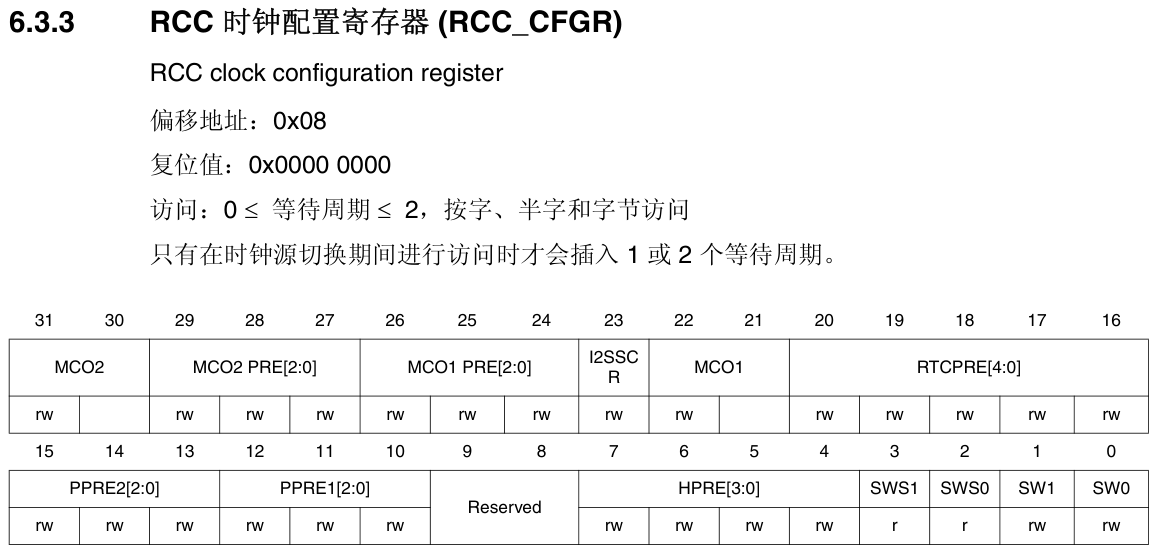
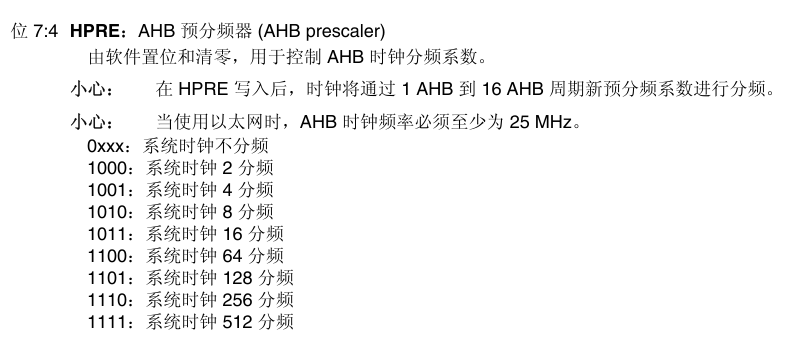
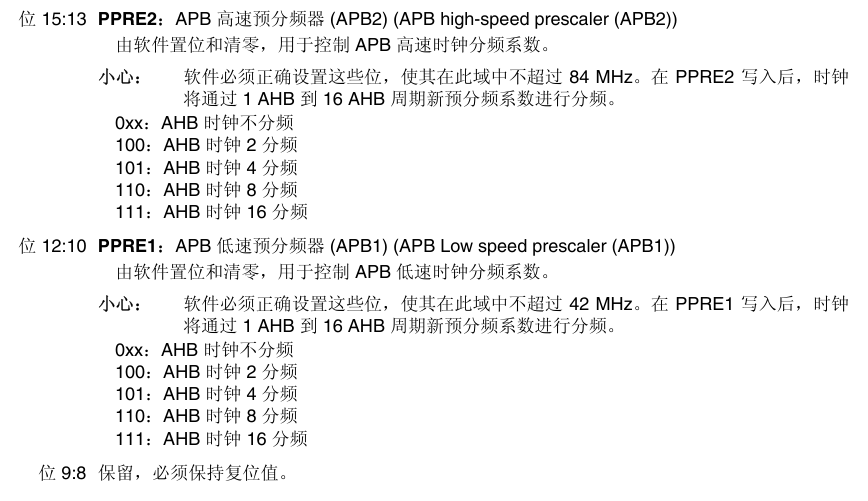
启动成功之后总线分频配置代码如下
/* HCLK = SYSCLK / 1*/
RCC->CFGR |= RCC_CFGR_HPRE_DIV1;
/* PCLK2 = HCLK / 2*/
RCC->CFGR |= RCC_CFGR_PPRE2_DIV2;
/* PCLK1 = HCLK / 4*/
RCC->CFGR |= RCC_CFGR_PPRE1_DIV4;
RCC PLL 配置寄存器
设置锁相环
[外链图片转存失败,源站可能有防盗链机制,建议将图片保存下来直接上传(img-M3eqhtBb-1664218657496)(https://picture-1309470925.cos.ap-chengdu.myqcloud.com/pic/image-20220926234025936.png)]
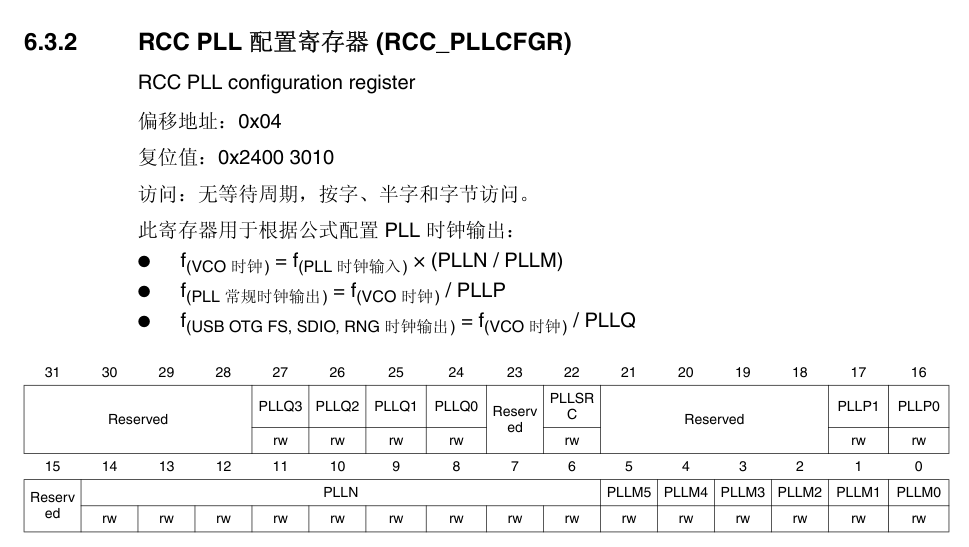
/* Configure the main PLL */
RCC->PLLCFGR = PLL_M | (PLL_N << 6) | (((PLL_P >> 1) -1) << 16) |
(RCC_PLLCFGR_PLLSRC_HSE) | (PLL_Q << 24);
/* Enable the main PLL */
RCC->CR |= RCC_CR_PLLON;
/* Wait till the main PLL is ready */
while((RCC->CR & RCC_CR_PLLRDY) == 0)
{
}
这里为RCC_CFGR配置,选择锁相环时钟
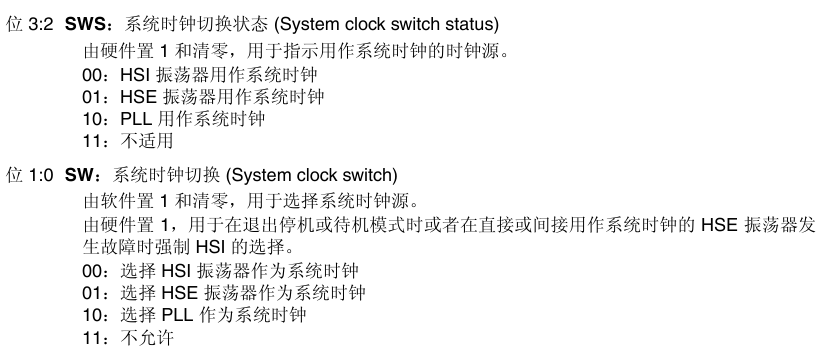
/* Select the main PLL as system clock source */
RCC->CFGR &= (uint32_t)((uint32_t)~(RCC_CFGR_SW));
RCC->CFGR |= RCC_CFGR_SW_PLL;
/* Wait till the main PLL is used as system clock source */
while ((RCC->CFGR & (uint32_t)RCC_CFGR_SWS ) != RCC_CFGR_SWS_PLL);
{
}
精简后的代码
原版
#include "bsp_rcc.h"
static void SetSysClock(void)
{
__IO uint32_t StartUpCounter = 0, HSEStatus = 0;
/* 1--------Enable HSE----------*/
RCC->CR |= ((uint32_t)RCC_CR_HSEON);
/* Wait till HSE is ready and if Time out is reached exit */
do
{
HSEStatus = RCC->CR & RCC_CR_HSERDY;
StartUpCounter++;
} while((HSEStatus == 0) && (StartUpCounter != HSE_STARTUP_TIMEOUT));
if ((RCC->CR & RCC_CR_HSERDY) != RESET)
{
HSEStatus = (uint32_t)0x01;
}
else
{
HSEStatus = (uint32_t)0x00;
}
/* 2--------HSE启动成功,配置AHB APB1 APB2的分频因子----------*/
if (HSEStatus == (uint32_t)0x01)
{
/* Select regulator voltage output Scale 1 mode */
RCC->APB1ENR |= RCC_APB1ENR_PWREN;
PWR->CR |= PWR_CR_VOS;
/* HCLK = SYSCLK / 1*/
RCC->CFGR |= RCC_CFGR_HPRE_DIV1;
/* PCLK2 = HCLK / 2*/
RCC->CFGR |= RCC_CFGR_PPRE2_DIV2;
/* PCLK1 = HCLK / 4*/
RCC->CFGR |= RCC_CFGR_PPRE1_DIV4;
/* 3.--------配置PLL的各项分频因子,并使能----------*/
RCC->PLLCFGR = PLL_M | (PLL_N << 6) | (((PLL_P >> 1) -1) << 16) |
(RCC_PLLCFGR_PLLSRC_HSE) | (PLL_Q << 24);
/* Enable the main PLL */
RCC->CR |= RCC_CR_PLLON;
/* Wait till the main PLL is ready */
while((RCC->CR & RCC_CR_PLLRDY) == 0)
{
}
/* Enable the Over-drive to extend the clock frequency to 180 Mhz */
PWR->CR |= PWR_CR_ODEN;
while((PWR->CSR & PWR_CSR_ODRDY) == 0)
{
}
PWR->CR |= PWR_CR_ODSWEN;
while((PWR->CSR & PWR_CSR_ODSWRDY) == 0)
{
}
/* Configure Flash prefetch, Instruction cache, Data cache and wait state */
FLASH->ACR = FLASH_ACR_PRFTEN | FLASH_ACR_ICEN |FLASH_ACR_DCEN |FLASH_ACR_LATENCY_5WS;
/* 4.--------选择系统时钟,这里是使用PLL时钟----------*/
RCC->CFGR &= (uint32_t)((uint32_t)~(RCC_CFGR_SW));
RCC->CFGR |= RCC_CFGR_SW_PLL;
/* Wait till the main PLL is used as system clock source */
while ((RCC->CFGR & (uint32_t)RCC_CFGR_SWS ) != RCC_CFGR_SWS_PLL);
{
}
}
else
{ /* If HSE fails to start-up, the application will have wrong clock
configuration. User can add here some code to deal with this error */
}
}
使用固件库编程
/*使用固件库超频
m: 2-63
n: 192-432
p: 2,4,6,8
q: 2-15
SYSCLK = (HSE/m)*n/p = 25/25*432/2=216M
*/
void HSE_SetSysClock(uint32_t m ,uint32_t n,uint32_t p,uint32_t q){
uint32_t HSEStartupStatus = 0;
//使能HSE
RCC_HSEConfig(RCC_HSE_ON);
//检测HSE是否已经启动成功
HSEStartupStatus = RCC_WaitForHSEStartUp();
if(HSEStartupStatus == SUCCESS){
/* 选择电压调节器件,输出模式为1 */
/* 使能电源使能时钟*/
RCC->APB1ENR |= RCC_APB1ENR_PWREN;
PWR->CR |= PWR_CR_VOS;
RCC_HCLKConfig(RCC_SYSCLK_Div1);
RCC_PCLK1Config(RCC_SYSCLK_Div4);
RCC_PCLK2Config(RCC_SYSCLK_Div2);
//设置PLL锁相环
RCC_PLLConfig(RCC_PLLSource_HSE,m,n,p,q);
//使能PPL
RCC_PLLCmd(ENABLE);
//检验是否已经使能
while(RCC_GetFlagStatus(RCC_FLAG_PLLRDY) == RESET){}
/* Enable the Over-drive to extend the clock frequency to 180 Mhz */
PWR->CR |= PWR_CR_ODEN;
while((PWR->CSR & PWR_CSR_ODRDY) == 0)
{
}
PWR->CR |= PWR_CR_ODSWEN;
while((PWR->CSR & PWR_CSR_ODSWRDY) == 0)
{
}
/* Configure Flash prefetch, Instruction cache, Data cache and wait state */
FLASH->ACR = FLASH_ACR_PRFTEN | FLASH_ACR_ICEN |FLASH_ACR_DCEN |FLASH_ACR_LATENCY_5WS;
RCC_SYSCLKConfig(RCC_SYSCLKSource_PLLCLK);
}
else{//启动失败,添加纠错代码
}
}
/**
* @brief Configures the External High Speed oscillator (HSE).
* @note After enabling the HSE (RCC_HSE_ON or RCC_HSE_Bypass), the application
* software should wait on HSERDY flag to be set indicating that HSE clock
* is stable and can be used to clock the PLL and/or system clock.
* @note HSE state can not be changed if it is used directly or through the
* PLL as system clock. In this case, you have to select another source
* of the system clock then change the HSE state (ex. disable it).
* @note The HSE is stopped by hardware when entering STOP and STANDBY modes.
* @note This function reset the CSSON bit, so if the Clock security system(CSS)
* was previously enabled you have to enable it again after calling this
* function.
* @param RCC_HSE: specifies the new state of the HSE.
* This parameter can be one of the following values:
* @arg RCC_HSE_OFF: turn OFF the HSE oscillator, HSERDY flag goes low after
* 6 HSE oscillator clock cycles.
* @arg RCC_HSE_ON: turn ON the HSE oscillator
* @arg RCC_HSE_Bypass: HSE oscillator bypassed with external clock
* @retval None
*/
void RCC_HSEConfig(uint8_t RCC_HSE)
{
/* Check the parameters */
assert_param(IS_RCC_HSE(RCC_HSE));
/* Reset HSEON and HSEBYP bits before configuring the HSE ------------------*/
*(__IO uint8_t *) CR_BYTE3_ADDRESS = RCC_HSE_OFF;
/* Set the new HSE configuration -------------------------------------------*/
*(__IO uint8_t *) CR_BYTE3_ADDRESS = RCC_HSE;
}
/**
* @brief Waits for HSE start-up.
* @note This functions waits on HSERDY flag to be set and return SUCCESS if
* this flag is set, otherwise returns ERROR if the timeout is reached
* and this flag is not set. The timeout value is defined by the constant
* HSE_STARTUP_TIMEOUT in stm32f4xx.h file. You can tailor it depending
* on the HSE crystal used in your application.
* @param None
* @retval An ErrorStatus enumeration value:
* - SUCCESS: HSE oscillator is stable and ready to use
* - ERROR: HSE oscillator not yet ready
*/
ErrorStatus RCC_WaitForHSEStartUp(void)
{
__IO uint32_t startupcounter = 0;
ErrorStatus status = ERROR;
FlagStatus hsestatus = RESET;
/* Wait till HSE is ready and if Time out is reached exit */
do
{
hsestatus = RCC_GetFlagStatus(RCC_FLAG_HSERDY);
startupcounter++;
} while((startupcounter != HSE_STARTUP_TIMEOUT) && (hsestatus == RESET));
if (RCC_GetFlagStatus(RCC_FLAG_HSERDY) != RESET)
{
status = SUCCESS;
}
else
{
status = ERROR;
}
return (status);
}
void RCC_PLLConfig(uint32_t RCC_PLLSource, uint32_t PLLM, uint32_t PLLN, uint32_t PLLP, uint32_t PLLQ)
{
/* Check the parameters */
assert_param(IS_RCC_PLL_SOURCE(RCC_PLLSource));
assert_param(IS_RCC_PLLM_VALUE(PLLM));
assert_param(IS_RCC_PLLN_VALUE(PLLN));
assert_param(IS_RCC_PLLP_VALUE(PLLP));
assert_param(IS_RCC_PLLQ_VALUE(PLLQ));
RCC->PLLCFGR = PLLM | (PLLN << 6) | (((PLLP >> 1) -1) << 16) | (RCC_PLLSource) |
(PLLQ << 24);
}
/**
* @brief Configures the system clock (SYSCLK).
* @note The HSI is used (enabled by hardware) as system clock source after
* startup from Reset, wake-up from STOP and STANDBY mode, or in case
* of failure of the HSE used directly or indirectly as system clock
* (if the Clock Security System CSS is enabled).
* @note A switch from one clock source to another occurs only if the target
* clock source is ready (clock stable after startup delay or PLL locked).
* If a clock source which is not yet ready is selected, the switch will
* occur when the clock source will be ready.
* You can use RCC_GetSYSCLKSource() function to know which clock is
* currently used as system clock source.
* @param RCC_SYSCLKSource: specifies the clock source used as system clock.
* This parameter can be one of the following values:
* @arg RCC_SYSCLKSource_HSI: HSI selected as system clock source
* @arg RCC_SYSCLKSource_HSE: HSE selected as system clock source
* @arg RCC_SYSCLKSource_PLLCLK: PLL selected as system clock source (RCC_SYSCLKSource_PLLPCLK for STM32F446xx devices)
* @arg RCC_SYSCLKSource_PLLRCLK: PLL R selected as system clock source only for STM32F412xG, STM32F413_423xx and STM32F446xx devices
* @retval None
*/
void RCC_SYSCLKConfig(uint32_t RCC_SYSCLKSource)
{
uint32_t tmpreg = 0;
/* Check the parameters */
assert_param(IS_RCC_SYSCLK_SOURCE(RCC_SYSCLKSource));
tmpreg = RCC->CFGR;
/* Clear SW[1:0] bits */
tmpreg &= ~RCC_CFGR_SW;
/* Set SW[1:0] bits according to RCC_SYSCLKSource value */
tmpreg |= RCC_SYSCLKSource;
/* Store the new value */
RCC->CFGR = tmpreg;
}
源代码流程
在项目启动的时候
Reset_Handler PROC
EXPORT Reset_Handler [WEAK]
IMPORT SystemInit
IMPORT __main
LDR R0, =SystemInit
BLX R0
LDR R0, =__main
BX R0
ENDP
找到SystemInit函数的原型
void SystemInit(void)
{
/* FPU settings ------------------------------------------------------------*/
#if (__FPU_PRESENT == 1) && (__FPU_USED == 1)
SCB->CPACR |= ((3UL << 10*2)|(3UL << 11*2)); /* set CP10 and CP11 Full Access */
#endif
/* Reset the RCC clock configuration to the default reset state ------------*/
/* Set HSION bit */
RCC->CR |= (uint32_t)0x00000001;
/* Reset CFGR register */
RCC->CFGR = 0x00000000;
/* Reset HSEON, CSSON and PLLON bits */
RCC->CR &= (uint32_t)0xFEF6FFFF;
/* Reset PLLCFGR register */
RCC->PLLCFGR = 0x24003010;
/* Reset HSEBYP bit */
RCC->CR &= (uint32_t)0xFFFBFFFF;
/* Disable all interrupts */
RCC->CIR = 0x00000000;
#if defined(DATA_IN_ExtSRAM) || defined(DATA_IN_ExtSDRAM)
SystemInit_ExtMemCtl();
#endif /* DATA_IN_ExtSRAM || DATA_IN_ExtSDRAM */
/* Configure the System clock source, PLL Multiplier and Divider factors,
AHB/APBx prescalers and Flash settings ----------------------------------*/
SetSysClock();
/* Configure the Vector Table location add offset address ------------------*/
#ifdef VECT_TAB_SRAM
SCB->VTOR = SRAM_BASE | VECT_TAB_OFFSET; /* Vector Table Relocation in Internal SRAM */
#else
SCB->VTOR = FLASH_BASE | VECT_TAB_OFFSET; /* Vector Table Relocation in Internal FLASH */
#endif
}
其中的SetSysClock()函数是关键
static void SetSysClock(void)
{
#if defined(STM32F40_41xxx) || defined(STM32F427_437xx) || defined(STM32F429_439xx) || defined(STM32F401xx) || defined(STM32F412xG) || defined(STM32F413_423xx) || defined(STM32F446xx)|| defined(STM32F469_479xx)
/******************************************************************************/
/* PLL (clocked by HSE) used as System clock source */
/******************************************************************************/
__IO uint32_t StartUpCounter = 0, HSEStatus = 0;
/* Enable HSE */
RCC->CR |= ((uint32_t)RCC_CR_HSEON);
/* Wait till HSE is ready and if Time out is reached exit */
do
{
HSEStatus = RCC->CR & RCC_CR_HSERDY;
StartUpCounter++;
} while((HSEStatus == 0) && (StartUpCounter != HSE_STARTUP_TIMEOUT));
if ((RCC->CR & RCC_CR_HSERDY) != RESET)
{
HSEStatus = (uint32_t)0x01;
}
else
{
HSEStatus = (uint32_t)0x00;
}
if (HSEStatus == (uint32_t)0x01)
{
/* Select regulator voltage output Scale 1 mode */
RCC->APB1ENR |= RCC_APB1ENR_PWREN;
PWR->CR |= PWR_CR_VOS;
/* HCLK = SYSCLK / 1*/
RCC->CFGR |= RCC_CFGR_HPRE_DIV1;
#if defined(STM32F40_41xxx) || defined(STM32F427_437xx) || defined(STM32F429_439xx) || defined(STM32F412xG) || defined(STM32F446xx) || defined(STM32F469_479xx)
/* PCLK2 = HCLK / 2*/
RCC->CFGR |= RCC_CFGR_PPRE2_DIV2;
/* PCLK1 = HCLK / 4*/
RCC->CFGR |= RCC_CFGR_PPRE1_DIV4;
#endif /* STM32F40_41xxx || STM32F427_437x || STM32F429_439xx || STM32F412xG || STM32F446xx || STM32F469_479xx */
#if defined(STM32F401xx) || defined(STM32F413_423xx)
/* PCLK2 = HCLK / 1*/
RCC->CFGR |= RCC_CFGR_PPRE2_DIV1;
/* PCLK1 = HCLK / 2*/
RCC->CFGR |= RCC_CFGR_PPRE1_DIV2;
#endif /* STM32F401xx || STM32F413_423xx */
#if defined(STM32F40_41xxx) || defined(STM32F427_437xx) || defined(STM32F429_439xx) || defined(STM32F401xx) || defined(STM32F469_479xx)
/* Configure the main PLL */
RCC->PLLCFGR = PLL_M | (PLL_N << 6) | (((PLL_P >> 1) -1) << 16) |
(RCC_PLLCFGR_PLLSRC_HSE) | (PLL_Q << 24);
#endif /* STM32F40_41xxx || STM32F401xx || STM32F427_437x || STM32F429_439xx || STM32F469_479xx */
#if defined(STM32F412xG) || defined(STM32F413_423xx) || defined(STM32F446xx)
/* Configure the main PLL */
RCC->PLLCFGR = PLL_M | (PLL_N << 6) | (((PLL_P >> 1) -1) << 16) |
(RCC_PLLCFGR_PLLSRC_HSE) | (PLL_Q << 24) | (PLL_R << 28);
#endif /* STM32F412xG || STM32F413_423xx || STM32F446xx */
/* Enable the main PLL */
RCC->CR |= RCC_CR_PLLON;
/* Wait till the main PLL is ready */
while((RCC->CR & RCC_CR_PLLRDY) == 0)
{
}
#if defined(STM32F427_437xx) || defined(STM32F429_439xx) || defined(STM32F446xx) || defined(STM32F469_479xx)
/* Enable the Over-drive to extend the clock frequency to 180 Mhz */
PWR->CR |= PWR_CR_ODEN;
while((PWR->CSR & PWR_CSR_ODRDY) == 0)
{
}
PWR->CR |= PWR_CR_ODSWEN;
while((PWR->CSR & PWR_CSR_ODSWRDY) == 0)
{
}
/* Configure Flash prefetch, Instruction cache, Data cache and wait state */
FLASH->ACR = FLASH_ACR_PRFTEN | FLASH_ACR_ICEN |FLASH_ACR_DCEN |FLASH_ACR_LATENCY_5WS;
#endif /* STM32F427_437x || STM32F429_439xx || STM32F446xx || STM32F469_479xx */
#if defined(STM32F40_41xxx) || defined(STM32F412xG)
/* Configure Flash prefetch, Instruction cache, Data cache and wait state */
FLASH->ACR = FLASH_ACR_PRFTEN | FLASH_ACR_ICEN |FLASH_ACR_DCEN |FLASH_ACR_LATENCY_5WS;
#endif /* STM32F40_41xxx || STM32F412xG */
#if defined(STM32F413_423xx)
/* Configure Flash prefetch, Instruction cache, Data cache and wait state */
FLASH->ACR = FLASH_ACR_PRFTEN | FLASH_ACR_ICEN |FLASH_ACR_DCEN |FLASH_ACR_LATENCY_3WS;
#endif /* STM32F413_423xx */
#if defined(STM32F401xx)
/* Configure Flash prefetch, Instruction cache, Data cache and wait state */
FLASH->ACR = FLASH_ACR_PRFTEN | FLASH_ACR_ICEN |FLASH_ACR_DCEN |FLASH_ACR_LATENCY_2WS;
#endif /* STM32F401xx */
/* Select the main PLL as system clock source */
RCC->CFGR &= (uint32_t)((uint32_t)~(RCC_CFGR_SW));
RCC->CFGR |= RCC_CFGR_SW_PLL;
/* Wait till the main PLL is used as system clock source */
while ((RCC->CFGR & (uint32_t)RCC_CFGR_SWS ) != RCC_CFGR_SWS_PLL);
{
}
}
else
{ /* If HSE fails to start-up, the application will have wrong clock
configuration. User can add here some code to deal with this error */
}
#elif defined(STM32F410xx) || defined(STM32F411xE)
#if defined(USE_HSE_BYPASS)
/******************************************************************************/
/* PLL (clocked by HSE) used as System clock source */
/******************************************************************************/
__IO uint32_t StartUpCounter = 0, HSEStatus = 0;
/* Enable HSE and HSE BYPASS */
RCC->CR |= ((uint32_t)RCC_CR_HSEON | RCC_CR_HSEBYP);
/* Wait till HSE is ready and if Time out is reached exit */
do
{
HSEStatus = RCC->CR & RCC_CR_HSERDY;
StartUpCounter++;
} while((HSEStatus == 0) && (StartUpCounter != HSE_STARTUP_TIMEOUT));
if ((RCC->CR & RCC_CR_HSERDY) != RESET)
{
HSEStatus = (uint32_t)0x01;
}
else
{
HSEStatus = (uint32_t)0x00;
}
if (HSEStatus == (uint32_t)0x01)
{
/* Select regulator voltage output Scale 1 mode */
RCC->APB1ENR |= RCC_APB1ENR_PWREN;
PWR->CR |= PWR_CR_VOS;
/* HCLK = SYSCLK / 1*/
RCC->CFGR |= RCC_CFGR_HPRE_DIV1;
/* PCLK2 = HCLK / 2*/
RCC->CFGR |= RCC_CFGR_PPRE2_DIV1;
/* PCLK1 = HCLK / 4*/
RCC->CFGR |= RCC_CFGR_PPRE1_DIV2;
/* Configure the main PLL */
RCC->PLLCFGR = PLL_M | (PLL_N << 6) | (((PLL_P >> 1) -1) << 16) |
(RCC_PLLCFGR_PLLSRC_HSE) | (PLL_Q << 24);
/* Enable the main PLL */
RCC->CR |= RCC_CR_PLLON;
/* Wait till the main PLL is ready */
while((RCC->CR & RCC_CR_PLLRDY) == 0)
{
}
/* Configure Flash prefetch, Instruction cache, Data cache and wait state */
FLASH->ACR = FLASH_ACR_PRFTEN | FLASH_ACR_ICEN |FLASH_ACR_DCEN |FLASH_ACR_LATENCY_2WS;
/* Select the main PLL as system clock source */
RCC->CFGR &= (uint32_t)((uint32_t)~(RCC_CFGR_SW));
RCC->CFGR |= RCC_CFGR_SW_PLL;
/* Wait till the main PLL is used as system clock source */
while ((RCC->CFGR & (uint32_t)RCC_CFGR_SWS ) != RCC_CFGR_SWS_PLL);
{
}
}
else
{ /* If HSE fails to start-up, the application will have wrong clock
configuration. User can add here some code to deal with this error */
}
#else /* HSI will be used as PLL clock source */
/* Select regulator voltage output Scale 1 mode */
RCC->APB1ENR |= RCC_APB1ENR_PWREN;
PWR->CR |= PWR_CR_VOS;
/* HCLK = SYSCLK / 1*/
RCC->CFGR |= RCC_CFGR_HPRE_DIV1;
/* PCLK2 = HCLK / 2*/
RCC->CFGR |= RCC_CFGR_PPRE2_DIV1;
/* PCLK1 = HCLK / 4*/
RCC->CFGR |= RCC_CFGR_PPRE1_DIV2;
/* Configure the main PLL */
RCC->PLLCFGR = PLL_M | (PLL_N << 6) | (((PLL_P >> 1) -1) << 16) | (PLL_Q << 24);
/* Enable the main PLL */
RCC->CR |= RCC_CR_PLLON;
/* Wait till the main PLL is ready */
while((RCC->CR & RCC_CR_PLLRDY) == 0)
{
}
/* Configure Flash prefetch, Instruction cache, Data cache and wait state */
FLASH->ACR = FLASH_ACR_PRFTEN | FLASH_ACR_ICEN |FLASH_ACR_DCEN |FLASH_ACR_LATENCY_2WS;
/* Select the main PLL as system clock source */
RCC->CFGR &= (uint32_t)((uint32_t)~(RCC_CFGR_SW));
RCC->CFGR |= RCC_CFGR_SW_PLL;
/* Wait till the main PLL is used as system clock source */
while ((RCC->CFGR & (uint32_t)RCC_CFGR_SWS ) != RCC_CFGR_SWS_PLL);
{
}
#endif /* USE_HSE_BYPASS */
#endif /* STM32F40_41xxx || STM32F427_437xx || STM32F429_439xx || STM32F401xx || STM32F469_479xx */
}
因为不使用有源晶振(价格昂贵),精简上面的代码,并且只留下与429相关的
#include "bsp_rcc.h"
static void SetSysClock(void)
{
__IO uint32_t StartUpCounter = 0, HSEStatus = 0;
/* Enable HSE */
RCC->CR |= ((uint32_t)RCC_CR_HSEON);
/* Wait till HSE is ready and if Time out is reached exit */
do
{
HSEStatus = RCC->CR & RCC_CR_HSERDY;
StartUpCounter++;
} while((HSEStatus == 0) && (StartUpCounter != HSE_STARTUP_TIMEOUT));
if ((RCC->CR & RCC_CR_HSERDY) != RESET)
{
HSEStatus = (uint32_t)0x01;
}
else
{
HSEStatus = (uint32_t)0x00;
}
if (HSEStatus == (uint32_t)0x01)
{
/* Select regulator voltage output Scale 1 mode */
RCC->APB1ENR |= RCC_APB1ENR_PWREN;
PWR->CR |= PWR_CR_VOS;
/* HCLK = SYSCLK / 1*/
RCC->CFGR |= RCC_CFGR_HPRE_DIV1;
/* PCLK2 = HCLK / 2*/
RCC->CFGR |= RCC_CFGR_PPRE2_DIV2;
/* PCLK1 = HCLK / 4*/
RCC->CFGR |= RCC_CFGR_PPRE1_DIV4;
/* Configure the main PLL */
RCC->PLLCFGR = PLL_M | (PLL_N << 6) | (((PLL_P >> 1) -1) << 16) |
(RCC_PLLCFGR_PLLSRC_HSE) | (PLL_Q << 24);
/* Enable the main PLL */
RCC->CR |= RCC_CR_PLLON;
/* Wait till the main PLL is ready */
while((RCC->CR & RCC_CR_PLLRDY) == 0)
{
}
/* Enable the Over-drive to extend the clock frequency to 180 Mhz */
PWR->CR |= PWR_CR_ODEN;
while((PWR->CSR & PWR_CSR_ODRDY) == 0)
{
}
PWR->CR |= PWR_CR_ODSWEN;
while((PWR->CSR & PWR_CSR_ODSWRDY) == 0)
{
}
/* Configure Flash prefetch, Instruction cache, Data cache and wait state */
FLASH->ACR = FLASH_ACR_PRFTEN | FLASH_ACR_ICEN |FLASH_ACR_DCEN |FLASH_ACR_LATENCY_5WS;
/* Select the main PLL as system clock source */
RCC->CFGR &= (uint32_t)((uint32_t)~(RCC_CFGR_SW));
RCC->CFGR |= RCC_CFGR_SW_PLL;
/* Wait till the main PLL is used as system clock source */
while ((RCC->CFGR & (uint32_t)RCC_CFGR_SWS ) != RCC_CFGR_SWS_PLL);
{
}
}
else
{ /* If HSE fails to start-up, the application will have wrong clock
configuration. User can add here some code to deal with this error */
}
}
)
{
}
PWR->CR |= PWR_CR_ODSWEN;
while((PWR->CSR & PWR_CSR_ODSWRDY) == 0)
{
}
/* Configure Flash prefetch, Instruction cache, Data cache and wait state */
FLASH->ACR = FLASH_ACR_PRFTEN | FLASH_ACR_ICEN |FLASH_ACR_DCEN |FLASH_ACR_LATENCY_5WS;
/* Select the main PLL as system clock source */
RCC->CFGR &= (uint32_t)((uint32_t)~(RCC_CFGR_SW));
RCC->CFGR |= RCC_CFGR_SW_PLL;
/* Wait till the main PLL is used as system clock source */
while ((RCC->CFGR & (uint32_t)RCC_CFGR_SWS ) != RCC_CFGR_SWS_PLL);
{
}
}
else
{ /* If HSE fails to start-up, the application will have wrong clock
configuration. User can add here some code to deal with this error */
}
}





















 1302
1302











 被折叠的 条评论
为什么被折叠?
被折叠的 条评论
为什么被折叠?








